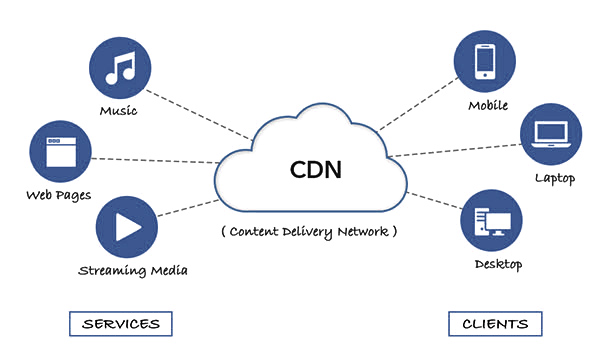What is a CDN
Content delivery networks (CDNs) are the Internet’s transparent backbone for content distribution. Every one of us interacts with CDNs on a regular basis, whether we realise it or not, when reading articles on news sites, purchasing online, watching YouTube videos, or scrolling through social media feeds.
Content delivery networks are likely behind every word of text, every image pixel, and every movie frame transmitted to your PC and mobile browser, regardless of what you do or what type of material you consume.
To understand why Content delivery networks are so popular, you must first understand the problem they were created to solve. Latency is the irritating wait that happens between the time you request a web page is loaded and the time its content appears onscreen.
A lot of factors influence the delay interval, many of which are unique to each web page. The physical distance between you and the website’s hosting server, however, affects the duration of the delay in all circumstances.
The purpose of a Content delivery network is to virtually shorten that physical distance, resulting in faster and more reliable site rendering.
How does a CDN Works?
A Content delivery network caches a cached version of your website’s content in many geographical locations to reduce the distance between users and your website’s server (a.k.a., points of presence, or PoPs). Each PoP has a number of cache servers that are in charge of delivering content to visitors in the area.
In essence, a Content delivery network distributes your material to multiple locations at once, giving your users better coverage. When someone in London visits your US-hosted website, for example, they do so through a local UK PoP. This is far more efficient than having the visitor’s inquiries and your responses travel the length and breadth of the Atlantic.
In a nutshell, this is how Content delivery network works. Of course, the rabbit hole deepens, since we assumed we’d need an entire book to explain the inner workings of content delivery networks.
Who uses a CDN?
Almost all of them. Content delivery networks already provide more than 50% of all traffic today. With each passing year, those figures are constantly increasing. There are a few reasons not to use a CDN if any aspect of your organisation is online, especially since many of them offer their services for free.
Content delivery networks aren’t for everyone, even as a free service. In particular, if you have a strictly localised website with the vast majority of your users in the same location as your hosting, a Content delivery network will provide little benefit. Using a CDN in this situation can actually degrade your website’s performance by adding another unnecessary connection point between the user and an existing nearby server.
However, because most websites operate on a bigger scale, Content delivery networks are a common solution in the following industries:
Advertising
Entertainment and the media
Gaming on the internet
E-commerce
Mobile
Healthcare
A more advanced education
Government
CDN Building Blocks
CDN PoPs (Points of Presence) are data centers strategically situated to communicate with users in their immediate area. Their primary goal is to cut down on round trip time by providing material closer to the website’s visitors. Typically, each Content delivery network PoP has a large number of cache servers.
Caching servers
The storage and delivery of cached files is the responsibility of caching servers. Their primary purpose is to reduce bandwidth consumption and speed up page load times. Typically, each Content delivery networks cache server has numerous storage drives and a large quantity of RAM.
SSD/HDD + RAM
Cached data are kept on solid-state and hard-disk drives (SSD and HDD) or random-access memory (RAM) inside Content delivery networks caching servers, with the more frequently-used files being saved on the faster mediums. RAM is often utilised to store the most frequently accessed items because it is the fastest of the three.
Tips on CDN
A Content delivery network must be the default inbound gateway for all incoming traffic in order to function. You’ll need to change your root domain DNS configurations (e.g., domain.com) as well as your subdomain DNS configurations to accomplish this (e.g., www.domain.com, img.domain.com).
Change the A record for your root domain to point to one of the CDN’s IP ranges. Modify the CNAME record for each subdomain to point to a CDN-provided subdomain address (e.g., ns1.cdn.com). In both circumstances, the DNS directs all visitors to your CDN rather than your own server.
Don’t worry if any of this sounds perplexing. The majority of CDN providers now provide step-by-step instructions to guide you through the activation process. They also offer support through their customer service department. The entire process takes about five minutes and requires only a few copies and pastes.
The Evolution of CDNs
Since the 1990s, commercial CDNs have existed. They passed through multiple evolutionary stages before becoming the strong application delivery platform they are today, just like any other decades-old technology.
Market forces, such as new trends in content consumption and significant connection developments, impacted CDN development. Fiber optics and other modern communication technologies have permitted the latter.
Overall, there are three generations of CDN evolution, each of which introduces new capabilities, technologies, and concepts to the network architecture. Working in tandem, each generation saw the cost of CDN services fall, signaling the technology’s maturation into a mass-market product.
Feel free to visit our Casbay Australia Blog or Knowledge Base for more information about CDN hosting topics, you may check out the following relevant article:



